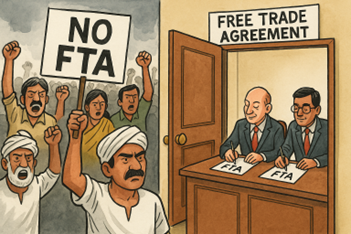



Why India’s next Free Trade Agreement must come with a memory, a mechanism—and a spine.
Another Free Trade Agreement is around the corner. This time, the suitor is the United States. The pitch is familiar: market access, strategic alignment, cheaper goods, global standing. But so is the undercurrent of unease. Behind the lofty talk of tariffs and tech lies a cold question: Will this lead to more trade—or more farmer suicides?
Consider a telling signal. A strategy paper doing the rounds suggests India could waive duties on American soyabean oil. For US exporters, it’s a dream. For India’s oilseed farmers, it’s a death sentence. Decades of volatility, low procurement, and import surges have already pushed them to the brink. And now, we’re planning to open the floodgates wider?
Have we forgotten so soon how we dismantled our domestic edible oil ecosystem in the name of liberalization? The result: a staggering $12 billion annual drain on our foreign exchange, just to import what our own farmers once grew. And now, after spending years and fortunes trying to revive the sector, this move feels like a bolt from the blue. A policy ambush from within.
If only oilseed farmers mirrored the farmers from Punjab, perhaps their plight would have found louder voices in the corridors of power. But they are scattered, silent, and sacrificial—easy to overlook, easier to trade away.
It forces us to ask: Does an FTA always mean fortune? Or sometimes, does it mean final rites for sectors already gasping?
India’s experience with FTAs is not a mystery—it’s a cautionary tale. Some have yielded modest benefits. But many have quietly haemorrhaged Indian industry while fattening foreign surpluses. Worse, we have no institutional spine to measure damage or demand redress. We sign the deal, issue a press release, and move on. No post-mortem, no penalty, no course correction.
ASEAN: A Pact That Keeps Taking
Take the India–ASEAN FTA. Signed in 2010, it was supposed to unlock Southeast Asia’s consumer markets. What we got instead was a one-way trade corridor—exports limped, imports roared.
India slashed tariffs on 71% of goods. ASEAN giants gave far less—Indonesia opened just 41%. Weak Rules of Origin let Chinese goods sneak in via ASEAN assembly lines. The result? A ballooning deficit—from $5 billion in 2010 to $43.6 billion in 2023. Indian industries—auto parts, light engineering, plantations—collapsed under the weight of duty-free competition. A review began in 2024. Nine rounds later, it’s still stuck in polite silence.
Let’s be clear: this isn’t about missed targets. It’s about a systemic refusal to ask tough questions. To demand audits. To call out failure.
And what of the India–Australia FTA? Announced with diplomatic sparkle and upgraded airline tiers, it gave frequent fliers platinum status, but gave trade itself the middle seat. Two years on, the volume is tepid, the optimism hollow, and the actual outcomes mostly anecdotal. Some data figures It’s less an agreement and more a polite cricket match—played at sunset, with no scorecard, and everyone agreeing not to bowl too fast. If ASEAN drained us, this one just leaves us politely nodding over PowerPoints.
The Invisible Umpires
Where are our institutions? Why are the Comptroller and Auditor General (CAG), the Reserve Bank of India (RBI), and NITI Aayog not in the room when these pacts are signed—or worse, when they go sour?
We keep the negotiating table stocked with officials from Commerce and External Affairs. But this isn’t a diplomatic pageant—it’s economic surgery. Why are the surgeons locked out?
The CAG has the forensic tools to examine tariff leakages, lopsided flows, and sectoral distress—but is never asked.
NITI Aayog could run real-time dashboards on how each FTA is faring—but remains a bystander.
The RBI watches capital outflows, current account stress, and currency tremors—but plays no part in shaping the trade that causes them.
Imagine running a cricket team with your best bowlers warming the bench. That’s how we treat our economic institutions. It’s time to bring them into the playing eleven. The game has long moved beyond the Ministry of Commerce.
The Fix: Monitor or Mourn
If India wants its next wave of FTAs to deliver growth—not grief—we need to build institutional muscle into the process. Not just at the start, but all the way through.
One, the CAG must be mandated to conduct a one-time performance audit of existing FTAs. Sector by sector. State by state. Let’s stop guessing and start measuring.
Two, NITI Aayog should maintain a live FTA dashboard. What’s working, what’s hurting, where to pause, and when to pull the brake.
Three, the RBI must assess the long-term impact of FTAs on external vulnerability—because today’s unchecked deficit is tomorrow’s macro crisis.
Let’s stop calling these trade pacts ceremonial. They are strategic contracts. They must serve India’s interest—or they must be restructured. If we don’t watch them, they will watch us unravel.
A New Kind of Tradecraft
India is not short on leverage. What we lack is memory—and muscle. FTAs are not handshakes; they’re contracts with consequences. Yet we keep signing them like we’re immune to pain.
No more self-inflicted wounds. No more trade-offs without accountability. Every deal must come with review clauses that bite, safeguards that activate on autopilot, and dashboards that show—clearly—who’s gaining and who’s bleeding.
Because if we don’t know what the last FTA did to us, we have no business signing the next one.
Once bitten, are we twice shy? Not yet. But we could be—if we bring CAG’s rigour, NITI’s realism, and RBI’s caution to the table. This isn’t just diplomacy anymore. It’s economic defence.
From hosted imbalance to strategic advantage.
From backroom diplomacy to hard-nosed tradecraft.
From photo-ops to measurable wins.
The question isn’t whether we ink the next FTA.
The question is—this time, will India finally show up with its full team?